
|   |

|   |
Ode to a guru - Veejay Sai, Bangalore e-mail: vs.veejaysai@gmail.com Images courtesy: Santosh Bankapur, Prithvi Krishna and Amith Nag May 24, 2012 The first image that comes to one’s mind when the name of Manju Bharghavi is evoked is the sensuous dance she performed in the role of the heroine in the blockbuster classic ‘Shankarabharanam.’ This May, Manju, one of the country’s finest exponents of Kuchipudi, completed five decades of her career as a dancer: not a mean feat to achieve! The test of a good guru is in the samskaram of the students they groom and Deepa was one to make her guru proud. To commemorate the event of Manju’s selfless services to dance, her senior student Deepa Sashindran held the two-day Natya Vedam dance festival on May 18 and 19 at a packed Chowdiah Memorial Hall in Bangalore. 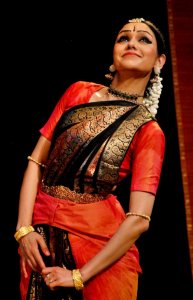 Rama Vaidyanathan The inaugural evening opened with a traditional Margam presentation by renowned dancer Rama Vaidyanathan. Opening with an invocatory Narayana Teertha’s Tarangam, Rama called her piece ‘The Divine Cowherd’. Depicting Lord Krishna who plays around tending to his herd and using that as a metaphor to convey the message of the human mind being tamed by divine will, Rama danced her way into everyone’s hearts present there. Dressed in a muted pink, as she swung to ‘ananda sundara thandava Krishnam’, a packed hall sat awestruck. She followed that with the famous Bhairavi varnam ‘Mohamana’ composed by the Tanjore Quartet brothers. What was interesting about Rama’s presentation of this oft-done varnam were the wonderful jathis composed by nattuvanaar Karaikudi Sivakumar. Changing the mood of the whole varnam and its usual choreography, Rama’s sancharis in each and every line were embellished with her arresting teermanams in her nritta. With a high degree of precision in Sivakumar’s jatis, one could see the same competence reflected in Rama’s dance. Her depiction of the procession of Lord Tyagesha and her sancharis for “Nagarigamana thirunagaril” could have gone on forever with the sophistication she presented it with. The unusual stillness and space she created in her choreography, as she built it to a crescendo, was yet another interesting aspect of her presentation. She concluded her performance with a javali in ragam Surati and a thillana followed by Adi Shankara’s ‘Ardhanarishwara stuti’. Once again, it was a delightful experience to watch her as she delicately portrayed the graceful aspect of Shakthi and balanced it with that of the aggressive yogic charmer Shiva. Doing the balancing act till the end of the last line, one could see how Rama tastefully shifted her eyes in Shiva and Shakthi forms.  Manju Bharghavi and group The second performance for the evening was none other than Manju Bharghavi herself! Presenting her Kuchipudi choreography ‘Sri Lalitha Nrithyarchanam’, Manju explored the various aspects of the divine goddess as written in the Ashtothara Shatanamavali written by sage Agastya in the Brahmanda Puranam. Getting the Sanskrit work translated completely into Telugu by Rallapalli Kavitha Prasad, one couldn’t believe the accuracy of the sahityam and the underlying philosophy. Beginning with the traditional opening prayer to the resident goddess of Kuchipudi village and adding her birudu as a part of the offering, Manju’s mukhabhinayam was worth a thousand eyes. Opening with slokas from Adi Shankara’s Soundarya Lahiri and interspersing her dance choreography with the entry of a traditional curtain with the motif of the Sri Chakram on it, all the ashtadasha shakthi peethams were introduced through the course of the production. Noteworthy was the dance of young Vaidehi from Sangli who danced in the group interspersing the narrative and playing the role of a sutradhaar. The concluding frieze of Manju as goddess Lalita with flowers showering on her amidst bells ringing was a bit filmy but impressive, a visually arresting frieze that audiences would jot down in their memories for days to come. The second evening’s program opened with a choreographic performance by Singapore-based dancer Gayathri Sriram. A student of guru Minal Prabhu, Gayathri has an enviable stage presence, but she decided to present a tediously long and repetitive choreographic work on Sita. Starting with Sita’s swayamvaram, Gayathri went in circles, constantly creating flashback sequences and looping stories within stories. At some point, the audience seemed to have forgotten if she was portraying Sita or Rama or Ravana or a deer or an elephant. Her portrayal of the Vanavasam scene felt more like Rama and Sita had gone for a picnic in a jungle resort. The pathos of the character was lost in the one too many things Gayathri was anxious to present. Lava and Kusha, held in arms like little puppies suddenly grow at a filmy speed and there were too many things happening in each story. Sita gets into the fire like she was going into a sauna. The smartness of choreography is knowing what to edit out in a presentation. There was no need to go into the whole story all over again, especially when nothing new was being shown in the narrative or content. One would hope to see a good dancer like Gayathri present a traditional margam. The high point of the presentation was the wonderful voice of Balasubramanyam who provided vocal support. His vocal range in ragas like Nalinakanthi and Charukesi was impressive. 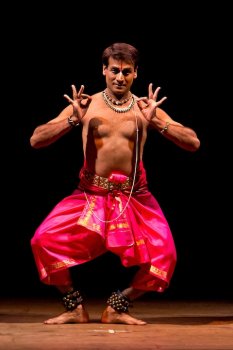 Sathyanarayana Raju 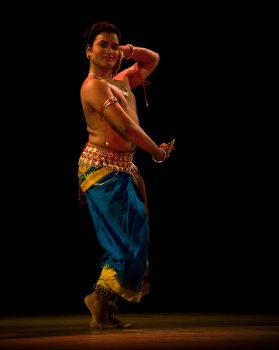 Lingaraj Pradhan 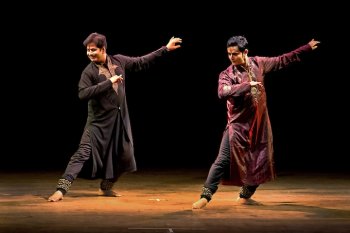 Muralimohan and Tushar Bhat 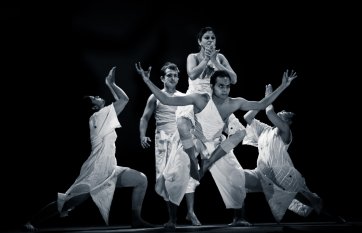 Natya Stem Dance Kampni The second performance for the evening was titled ‘Purusha’ and compered by dance historian Ashish Khokar who stressed the need for sabhas to encourage male dancers. Four dancers, Sathyanarayana Raju (Bharatanatyam), Lingaraj Pradhan (Odissi), Tushar Bhat and Muralimohan Kalvakalva (Kathak) opened with a group presentation performing a Ganesh Vandana. Following that was Sathya’s solo performance of a smart assortment of Annamacharya’s kritis starting from “Jaya janaki ramana” and going into “Sharanu sharanu” and “Narayanate namo namo”. Sathya is certainly one of the finest male soloists in our country and to see him performing is an absolute joy, though it would have been better to see him perform to a live orchestra instead of recorded tracks. Be it the clear lines in his pure nritta sequences or his abhinaya, he is flawless. This was followed by presentation in teen taal by the Kathak performers. Tushar Bhat has matured into an excellent performer. While it was wonderful to watch Tushar performing, the content of what they were presenting was bland with nothing new in format. Lingaraj Pradhan presented a brilliant solo performance of “Ahe Nila Saila”. Choreographed by the legendary Guru Kelucharan Mahapatra and directed by Guru Bichitrananda Swain, this is a very touching composition of the famous Muslim poet Salabega, who was struck with leprosy and prayed to Lord Jagannatha to cure him. Lingaraj’s sancharis portraying scenes from ‘Gajendra Moksham’ and ‘Draupadi Vastraapaharanam’ were worth watching for their freshness in abhinaya. Lingaraj is yet another dancer who needs to be seen more in the years to come and for now we must thank the festival organizers for bringing him to Bangalore audiences. The show ended with a patchy group dance where Sathya danced to a thillana which didn’t match with the Tarana that the Kathak performers danced to and was totally out of sync with the Moksha done by Lingaraj. Each of these dancers make for amazing soloists and it would probably be best to leave them to do solos without squeezing them all together. The second and final day of the festival ended in a disaster as technical glitches seemed to be the call of the hour leaving the performing artistes in a helpless state. The last performance was by Bangalore’s favourite contemporary dance group, the Natya STEM Dance Kampni headed by Madhu Natraj. Opening with a tarana in Raag Shankara titled ‘Sanjog’, depicting the common strings between the dance forms of Kathak and Flamenco, Madhu followed it by performing a solo thumri “Ab Ke Sawan” made famous by the legendary Begum Akhtar. It is always a delight to watch Madhu perform solo Kathak. She is one of the country’s finest Kathak dancers, totally underrated and underexposed and overshadowed by her fame as being a contemporary dancer. This was followed by excerpts from ‘Vajra’, the STEM Dance Kampni’s latest production. It was disheartening to see so many technical glitches ruin what would have been a wonderful finale to the festival. This is the first time Deepa Sashindran is organizing a festival and hope she learns from this experience. For now, we can congratulate her for her first venture and wish her the best for the next. Veejay Sai is a writer, editor and a culture critic. |